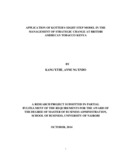Application of kotter’s eight step model in the management of strategic change at British American tobacco Kenya
| dc.contributor.author | Kang’ethe, Anne N | |
| dc.date.accessioned | 2014-12-04T09:00:15Z | |
| dc.date.available | 2014-12-04T09:00:15Z | |
| dc.date.issued | 2014-10 | |
| dc.identifier.uri | http://hdl.handle.net/11295/76343 | |
| dc.description.abstract | The business environment is very dynamic with various forces bombarding the organizations. It is hence imperative for the organizations to put in place strategies for adapting and adopting new practices that will enable the organizations successfully survive the tides. In doing this the organizations need not rel y on experience and old way s of doing things. It is imperative f or organizations to adopt tried processes that will enable them achieve their change objectives within the limited time and using the limited resources. Many models have been suggested to guide the change process. These models can be adopted by organizatio ns in order to manage the change process successfully and in an efficient manner . This study mainly focused on Kotter‟s eight step model. The study aimed at determining the change management process adopted by BAT Kenya . It also tried to determine to what extent does the change management process compare and relate to Kotter‟s eight step model. The study also aimed at establishing the challenges encountered by BAT Kenya in the process of managing change. This research adopted a case study research design wi th focus on BAT Kenya. Data collection was done by use o f interview guides . The interviewees were five key managers at BAT . Content a nalysis was then carried out on the collected data and generalizations drawn to achieve the objectives of study. The resear ch study has shown that BAT is responsive to changes in the environment and has put functions in its structure to handle change as and when needed. Research study has also shown that BAT adopts Kotter‟s eight step model in the management of change of the bigger projects in that it has followed the eight steps and has only skipped a few steps when it was handling smaller projects. The researcher recommends the firm focuses and invests more on human capital which is inimitable in order to remain compe titive in the industry | en_US |
| dc.language.iso | en | en_US |
| dc.publisher | University of Nairobi | en_US |
| dc.title | Application of kotter’s eight step model in the management of strategic change at British American tobacco Kenya | en_US |
| dc.type | Thesis | en_US |
| dc.type.material | en_US | en_US |

